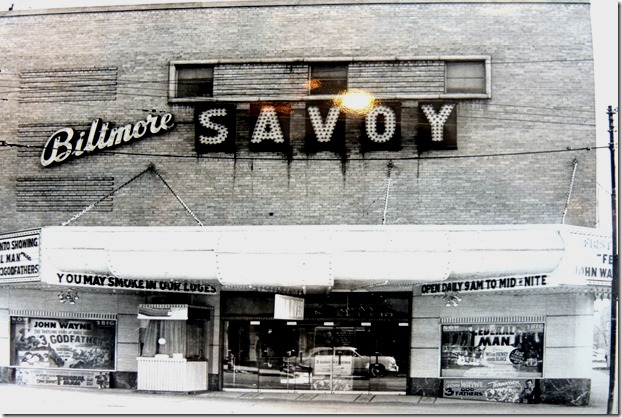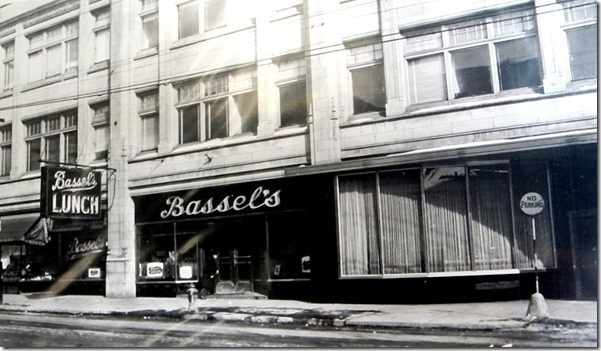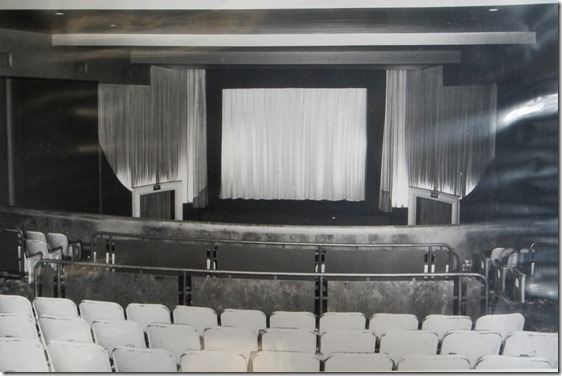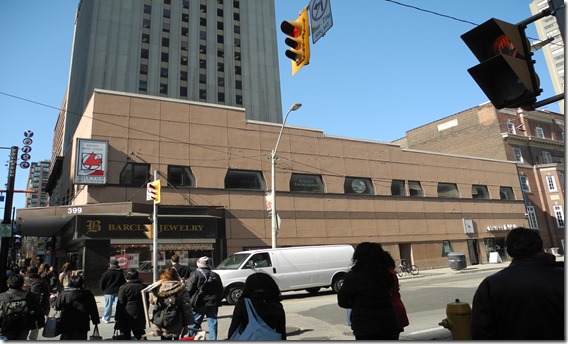Savoy Theatre c. 1963, the film “The Three Godfathers” having been released in 1948. Photo, Ontario Archives, AO 2273
As a teenager in the 1950s, I sometimes journeyed downtown to attend the Savoy Theatre at 399 Yonge Street. On one occasion, on a hot summer’s day, I went by myself to a matinee in the theatre. Some of the patrons appeared unusually rough, causing me to wonder if there had been a prison break at the Don Jail, and following the escape they had all gathered at the Savoy. Being about sixteen years old at the time, I had a wild imagination. When one of the jailbird types sat next to me, I departed the theatre. Until I was older, I did not attend the theatre again on my own.
Many teenagers were attracted to the Savoy Theatre in the 1950s as it was ideally located, since it was on a particularly active and quirky section of the Yonge Street strip. It screened horror flicks and restricted films, and did not vigorously enforce the age-restriction laws. The Savoy was on the northeast corner of Gerrard and Yonge Streets. On the southeast corner was Bassel’s Restaurant, an enormous eatery that occupied the equivalent of four average-size shops. After viewing a film, my friends and I thought that the restaurant was a great spot for a coffee and a western sandwich. Besides, Bassel’s large windows overlooking Yonge were wonderful for overlooking the antics on the street. Another favourite eating place in that decade was on the opposite (west) side of Yonge, a little further north of the Savoy—the “Pickin’ Chicken.” In this restaurant they served deep-fried chicken, coleslaw and french fries in a wicker basket. It was a forerunner of KFC. In my late-teen years, when attending the Savoy, one of these restaurants was often included in the visit.
Bassel’s Restaurant in the 1950s, on the southeast corner of Gerrard and Yonge Streets. Photo, City of Toronto Archives
The Savoy Theatre opened in 1951, a part of the Biltmore Chain, which also had theatres in the town of Weston (Weston Road and Lawrence Avenue West) and also in New Toronto (Lakeshore Road and 3rd Street). The Savoy on Yonge Street possessed around 1000 seats, including the balcony. Its yellow-brick façade was unadorned, its height the equivalent of three storeys. On the top floor there were small windows facing Yonge Street, the space behind them likely occupied by offices and perhaps storage rooms. The theatre’s expansive marquee spanned the entire front of the building. Large glass doors gave access to the theatre, the box office situated at the edge of the sidewalk, to the left of the doors. On either side of the front of the building, billboard space advertised current films as well as future attractions.
By the late-1950s and early-1960s, the theatre began to deteriorate. British Odeon Theatres leased the theatre from the smaller Biltmore chain in 1963, extensively renovated it and reopened it as the Coronet Theatre. However, despite the upgrades, the theatre continued to lose business. The Odeon chain relinquished control of the theatre in 1978. It then became a true “grindhouse cinema,” offering as many as five films for the single admission price of $3.50. For a few years, it screened soft-core porn. During this period, because attendance had diminished, the balcony was closed.
The Coronet was equipped to screen 3-D films, one of the most memorable being “Frankenstein,” a French-Italian horror film produced by Andy Warhol in 1973. Around the year 1980, it featured a 3-D festival. However, competition was fierce on the Yonge Street strip and as the theatre deteriorated, attendance continued to dwindle. This was similar to other smaller theatres on Yonge Street—the Rio and the Biltmore.
The building was sold in 1983 for over one million dollars and converted into Jewellery Exchange. Its yellow-brick façade was covered over with cement that was divided into sections to give the appearance of large stone blocks. The building survives today, a reminder of one of the well-known theatres that once lined Yonge Street.
View of the Savoy’s auditorium from the balcony. Photo, Ontario Archives
The northeast corner of Gerrard and Yonge Streets in 2014, where the Savoy/Coronet was located.
To view the Home Page for this blog: https://tayloronhistory.com/
To view previous blogs about movie houses of Toronto—historic and modern
Recent publication entitled “Toronto’s Theatres and the Golden Age of the Silver Screen,” by the author of this blog. The publication explores 50 of Toronto’s old theatres and contains over 80 archival photographs of the facades, marquees and interiors of the theatres. It relates anecdotes and stories of the author and others who experienced these grand old movie houses.
To place an order for this book:
Book also available in Chapter/Indigo, the Bell Lightbox Book Store and by phoning University of Toronto Press, Distribution: 416-667-7791
Theatres Included in the Book:
Chapter One – The Early Years—Nickelodeons and the First Theatres in Toronto
Theatorium (Red Mill) Theatre—Toronto’s First Movie Experience and First Permanent Movie Theatre, Auditorium (Avenue, PIckford), Colonial Theatre (the Bay), the Photodome, Revue Theatre, Picture Palace (Royal George), Big Nickel (National, Rio), Madison Theatre (Midtown, Capri, Eden, Bloor Cinema, Bloor Street Hot Docs), Theatre Without a Name (Pastime, Prince Edward, Fox)
Chapter Two – The Great Movie Palaces – The End of the Nickelodeons
Loew’s Yonge Street (Elgin/Winter Garden), Shea’s Hippodrome, The Allen (Tivoli), Pantages (Imperial, Imperial Six, Ed Mirvish), Loew’s Uptown
Chapter Three – Smaller Theatres in the pre-1920s and 1920s
Oakwood, Broadway, Carlton on Parliament Street, Victory on Yonge Street (Embassy, Astor, Showcase, Federal, New Yorker, Panasonic), Allan’s Danforth (Century, Titania, Music Hall), Parkdale, Alhambra (Baronet, Eve), St. Clair, Standard (Strand, Victory, Golden Harvest), Palace, Bedford (Park), Hudson (Mount Pleasant), Belsize (Crest, Regent), Runnymede
Chapter Four – Theatres During the 1930s, the Great Depression
Grant ,Hollywood, Oriole (Cinema, International Cinema), Eglinton, Casino, Radio City, Paramount, Scarboro, Paradise (Eve’s Paradise), State (Bloordale), Colony, Bellevue (Lux, Elektra, Lido), Kingsway, Pylon (Royal, Golden Princess), Metro
Chapter Five – Theatres in the 1940s – The Second World War and the Post-War Years
University, Odeon Fairlawn, Vaughan, Odeon Danforth, Glendale, Odeon Hyland, Nortown, Willow, Downtown, Odeon Carlton, Donlands, Biltmore, Odeon Humber, Town Cinema
Chapter Six – The 1950s Theatres
Savoy (Coronet), Westwood
Chapter Seven – Cineplex and Multi-screen Complexes
Cineplex Eaton Centre, Cineplex Odeon Varsity, Scotiabank Cineplex, Dundas Square Cineplex, The Bell Lightbox (TIFF)




![cid_E474E4F9-11FC-42C9-AAAD-1B66D852[2] cid_E474E4F9-11FC-42C9-AAAD-1B66D852[2]](https://tayloronhistory.com/wp-content/uploads/2015/01/cid_e474e4f9-11fc-42c9-aaad-1b66d8522_thumb3.jpg)